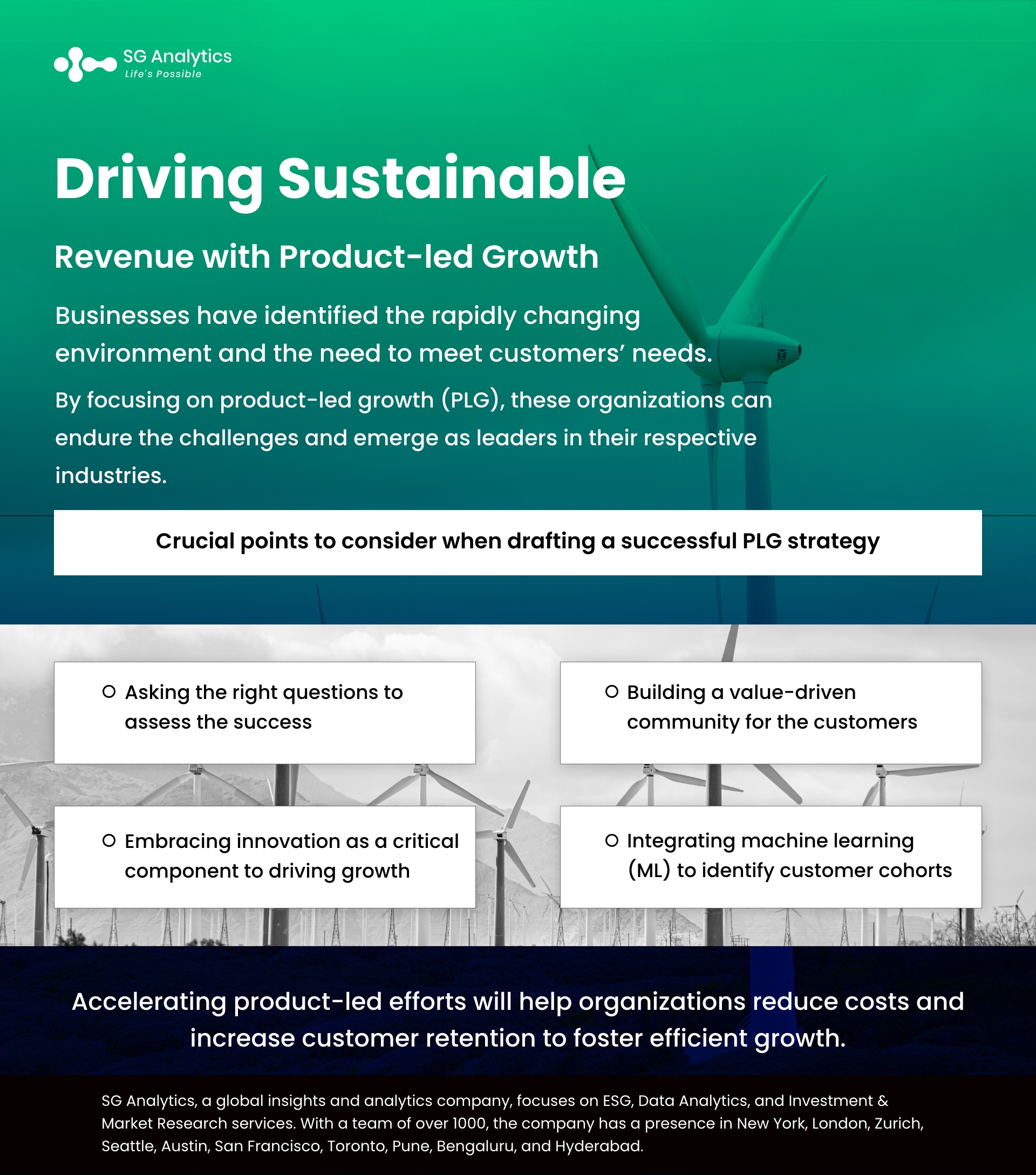While the pandemic turned out to be an economic boon for many organizations, it radically shifted consumer behavior. Due to this reason, in the last few years, companies including Zoom, Slack, Shopify, and Netflix perfectly positioned themselves for this transition, and many even experienced hypergrowth as a result.
These services were well-prepared to take advantage of the shift to remote work and other online activities. But one component that Zoom, Slack, and Netflix share is a common focus on product-led growth, referred to as PLG. These players were able to experience hypergrowth during the pandemic by providing their consumers with exceptional product experiences. They were able to identify the rapidly changing environment and meet customers' needs.
By focusing on product-led growth (PLG), these organizations were able to endure the challenges and emerge as leaders in their respective industries. This strategy is aimed at providing organizations with a path for sustained revenue growth while offering consumers an exceptional product experience and engagement. Let's have a closer look at the three Ws of customer engagement:
Who: The customer affiliates that need to be engaged or retained
What: The type of communication that must be sent
When: The best time to send this communication via a digital channel
Read more: The Future of Business Intelligence: Top Trends for 2023 and Beyond

Crucial Points to consider when Drafting a Successful PLG Strategy
The looming fear of higher-than-expected inflation and the global economic downturn has made the global markets tighter. The recent turmoil in public as well as private markets, made it evident that enterprises cannot thrive without capital-efficient and sustainable growth.
-
Asking the Right Questions to Assess the Success
Some of the key questions that can be embedded to assess the success of a product-led growth strategy are as follows:
- Is the product meeting customer needs as well as solving their problems?
- What is the overall customer acquisition cost, and is it trending over time?
- What percentage of growth is generated from product-led channels?
- How effectively are the data and analytics being used to drive product decisions and design the right go-to-market strategy?
- Is the organization able to retain as well as grow the existing customer base?
- Understanding the feedback from the customers on product features and implementing ways to improve
- Exploring new ways to integrate product, marketing, and sales efforts to drive growth
- How to build solid cross-functional alignment across the organization?
Answers to these questions will provide organizations with the right insights into the effectiveness of a product-led growth strategy. How an organization performs along these lines will help them in identifying and devising new strategies to enhance consumers' product experience.

-
Embracing Innovation as a Critical Component to Drive Growth
One of the critical components of product-led growth (PLG) is innovation. A product-led growth strategy demands continuity in delivering new and improved consumer experiences. By tweaking, testing, and measuring parts of the user experience, businesses can devise a stronger strategy that assists them in keeping the users more engaged while driving growth. Even in a period of increasing consumer thriftiness, businesses should work towards creating a culture of innovation where new ideas are encouraged and tested. This will help create more opportunities to learn and improve. Businesses are constantly innovating their operations with a clear focus on enhancing experience ranging from onboarding to delivering significant dividends, thereby enabling continued economic growth amid uncertainty.
Read more: Sustainability Outlook: Is ESG an Investment Strategy or a Path to Creating a Sustainable World?
Today product-led growth and innovation are critical components of a successful growth strategy, irrespective of external economic conditions. By positioning the customer at the center of the strategy and delivering new and improved experiences through innovation, companies can attract and retain their customers, drive engagement, and achieve sustainable revenue growth.
With a focus on product-led growth, companies can also lower their dependence on the rising cost of customer acquisition efforts.

-
Building a Value-driven Community for the Customers
While maintaining an enthusiastic customer base is important for business. It is equally vital to turn that user base into a community that will support one another and share knowledge. To build an effective network, it is important to get the users onboard, connect them, and create a space that fosters conversations. This will further aid organizations in amplifying their products among organic users.
With little effort from a company, a community can help in adding exponential value to the users. Today, establishing a community is a simple task and a great medium to monitor and engage with the audience. Tracking the amount of user-generated content as well as the number of members helps in providing a window into the community's health.
Organizations are now more focused on building a community for their consumers. These platforms will allow them to connect with their audience and understand their preferences and needs, inspiring an inclusive environment. Invariably, this will also help in discoverability through better SEO with user-generated content.
Read more: Integrating Data and Artificial Intelligence in Business Strategy to meet ESG Goals

With more focus on R&D for future iterations and a strong PLG strategy in place, businesses can reinvest in their products. Today, businesses are exploring more cost-effective ways to grow with a sustainable product value proposition. The aim to deliver a great customer experience is becoming more compelling, and customers are less likely to churn. This has led to the creation of new opportunities for enterprises that are embracing PLG and innovation to differentiate themselves from their competition, thereby enabling them to achieve sustained growth.
-
Integrating Machine Learning (ML) to Identify Customer Cohorts
Brands must start leveraging AI and machine learning to gather insights and predict their customer's behavior. By proactively identifying customers who are likely to make a purchase, businesses can create a targeted campaign to grow revenue as well as engage and retain their consumer base. Leveraging artificial intelligence enables businesses to determine the right communication channel.
Communication timings and channels play a vital role when it comes to delivering messages to customers. And messaging is considered a vital component in building relevant experiences for customers on and off the platforms. A message generally contains three key components:
-
Text which includes the subject lines, push notification text, etc.,
-
Media like images, videos, gif
-
Call to action

During times of economic slowdown, brands are now transitioning to AI to not only understand their consumer preferences but also to automatically pick the best time and channel for the highest ROI. They need to invest in artificial intelligence to optimize their messaging options with rigorous testing automatically. This can help them test promotional campaigns as well as measure the impact of their key metrics.
Read more: Debt Ceiling Standoff - Will the World’s Renowned Economic Safe Haven go into Default?
The Rise of Product-led Market Growth
A key finding from a recent report highlighted that organizations are either working towards implementing or accelerating the integration of Product-Led Growth (PLG) during the economic downturn. Utilizing products across all stages of the buyer journey is emerging as common practice. This rise of Product-Led Growth (PLG) is more than a buzzword. It presents businesses with innovative approaches to scale their operations and revenue. Instead of depending on investment in marketing and sales, PLG is enabling them to take a more organic approach, and users are becoming the main source of growth. This implies that the sales team is relying on a low-touch or zero-touch approach to secure new customers. Initiatives, including targeted cross-sell opportunities, self-guided tours, along with in-app promotions and ad campaigns, are presenting new opportunities for businesses to drive product-led growth.

Looking Foward: A Time to Adapt to Sustainable Growth
With the industry slowly recovering from this slowdown, it is vital to see how fast or slow the transition happens for individual companies depending on a lot of factors. However, there still seems to be one constant when we look back at the organizations that emerged from similar downturns the fastest, which is adaptability.
While uncertainties are still looming over the existing market conditions, it is important to see how quickly and effectively businesses will be able to adapt in the face of change. A growth mindset will be the only factor that will separate the winners in the industries. And accelerating product-led efforts will assist organizations when it comes to reducing costs and increasing customer retention to foster efficient growth.
With a presence in New York, San Francisco, Austin, Seattle, Toronto, London, Zurich, Pune, Bengaluru, and Hyderabad, SG Analytics, a pioneer in Research and Analytics, offers tailor-made services to enterprises worldwide.
A leader in Market Research services, SG Analytics enables organizations to achieve actionable insights into products, technology, customers, competition, and the marketplace to make insight-driven decisions. Contact us today if you are an enterprise looking to make critical data-driven decisions to prompt accelerated growth and breakthrough performance.









